The Hummingbirds' Gift
Air Date: Week of September 10, 2021
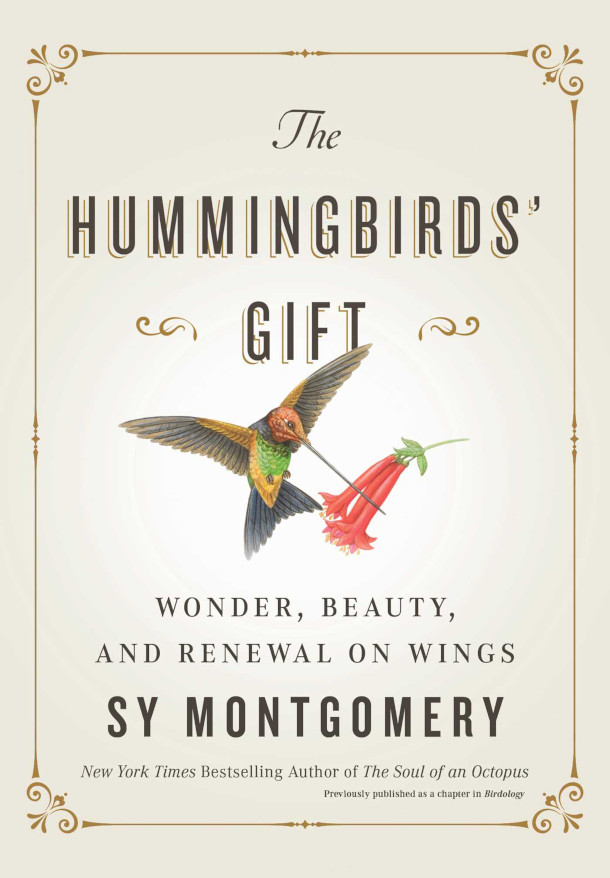
Sy Montgomery’s newest book, The Hummingbirds’ Gift: Wonder, Beauty, and Renewal on Wings . (Photo: Courtesy of Sy Montgomery and Simon & Schuster)
Hummingbirds are truly superlative creatures - relative to their size, they are both the world's fastest avians and have some of the longest migratory journeys of any creature. Sy Montgomery focuses on these incredible birds in her latest book, The Hummingbirds' Gift, where she looks back on her harrowing but rewarding time raising two orphaned baby hummingbirds alongside Brenda Sherburn LaBelle, an artist and hummingbird rehabilitator. Living on Earth's Bobby Bascomb visited Sy Montgomery at her home in New Hampshire to learn more.
Transcript
CURWOOD: It’s Living on Earth, I’m Steve Curwood.
As days grow shorter during fall in North America the instinct to migrate arises among many birds, including the smallest of avians, the hummingbirds. Nature is calling them South towards Central America. And what these tiny birds lack in size they make up for in vigor, with a heart rate of more than 1200 beats per minute and up to 70 wing flaps per second, depending on the species. Writer Sy Montgomery had the opportunity to help raise two baby hummingbirds alongside a hummingbird rehabilitator. She wrote about the experience in her latest book titled, The Hummingbird’s Gift: Wonder, Beauty, and Renewal on Wings. Living on Earth’s Bobby Bascomb visited Sy at her home in New Hampshire where she asked her what is the hummingbird’s gift?
MONTGOMERY: Well, the hummingbirds' gift is the gift that they gave to us. These were two orphaned baby hummingbirds who were just a few days old when they came into the hands of Brenda Sherburn LaBelle, who's a specialist hummingbird rehabilitator, but in rehabilitating them, in saving their lives, in being able to let them go free as adults, the gift that they gave us was giving us a hand in resurrection. They would have died, they came back from the dead, and to be able, essentially, to restore these amazing little birds to the sky. These birds that are superlative in so many ways, to have a hand in making that happen, is enormously empowering and inspiring. And particularly right now, you know, we've been through this pandemic and terrible period of environmental catastrophe and racial unrest and political upheaval. It's so good to have a story like this of a small miracle, reminding us that we can have a hand in restoring life.
BASCOMB: How did you get started with Brenda and the hummingbirds?
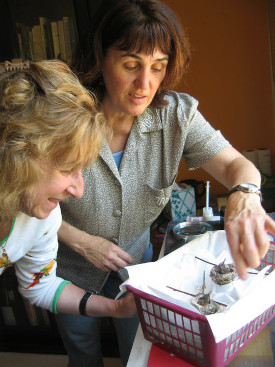
Brenda Sherburn LaBelle (rear) and Sy Montgomery (front) look at Zuni and Maya in their nests. (Photo: Courtesy of Sy Montgomery)
MONTGOMERY: I was actually writing an earlier book about birds. And each chapter in this book, which is called Birdology, was looking at a different aspect of birdiness. And one of the things about birds of course, is that birds are made of air and hummingbirds are the ones who illustrate that best. You know, most birds, their feathers outweigh their skeletons because their bones are hollow. Their bodies are filled with air sacs, a hummingbird has no fewer than nine big air sacs. And that's in addition to two huge lungs, and a giant heart. They are so air filled, that even giving them an injection, if they're sick, can pop an air sac and kill them. But it's this very fragility, the fact that they are little more than bubbles cloaked in these iridescent feathers, this is what gives them their superpowers of super flight. Because only hummingbirds can hover alone among birds, it may look sometimes like a seagull, for example, is hovering, but it's not really hovering. These guys can just hover in the middle of the air for minutes. And not only can they perform this acrobatic feat, but they're also per body length, a hummingbird is the longest migrant of all the birds in the world. It's because you know, it's so small. And if you're looking at the number of body lengths that it can travel, you know, flying from Alaska to Mexico, for somebody who's just a couple inches long. Imagine what a feat that is. And also they're superlative, in that they're the fastest birds in the sky, if you look at per body length. In fact, they travel faster in terms of body length through the sky than even the space shuttle when it screams down through the atmosphere. So these birds are supremely gifted with these amazing powers. And they owe all those powers to the very thing that makes them most vulnerable and fragile.
BASCOMB: It’s amazing. And so your friend, I think Brenda said, hey, I have these two hummingbirds. Can you come help me? And you said, I'm on a plane! I'll be there!
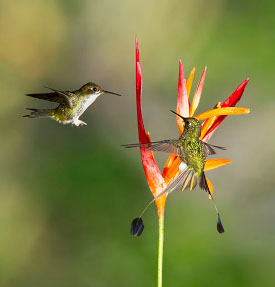
Booted Rackettail Hummingbirds (Photo: © Tianne Strombeck)
MONTGOMERY: Yeah, absolutely. I found Brenda. I mean, she's a friend of a friend. And the minute I met her, it was one of those wonderful things that you know, like, I want this person to be one of my best friends for the rest of my life. I mean, her kindness, her patience, her attention to detail, the fact that she was so dedicated. This is a really demanding thing to take care of these tiny little birds, it demands that every 20 minutes, from dawn to dusk, everything must stop because if you don't feed them every 20 minutes, they will starve. And you have to feed them exactly the right food and exactly the right amount. If they don't get enough, they'll starve but worse if they get too much, remember, they're little bubbles. They're made of air, they can pop and she's an artist. She's a sculptor. And you can't do any sculpting while you're taking care of an orphan baby hummingbird. So I so admired her and I was delighted to be able to help her and document what she was doing. So when these two little orphans showed up, she called me up. I got on the plane. I flew out as fast as I could.
BASCOMB: And you became a 24 hour a day nurse to these baby hummingbirds. Can you give us a little insight into a day in the life of a hummingbird rehabilitator?
MONTGOMERY: Yeah, you bet. First light, you got to be up, because that's when the hummingbirds get up. It's a little before dawn. And while normal people are grinding coffee, what we're grinding is fruit flies, because many people don't realize that hummingbirds need hundreds of insects to eat every day, in addition to nectar. So we're grinding up these frozen fruit flies with a mortar and pestle. And then we're mixing up the special elixir of nectar and vitamins and minerals and enzymes, and fixing it up. And the stuff, you can't just mix up a big batch and use it for the rest of the week. It goes bad very quickly. So we're fixing that up, we put it in a syringe. And then you've got attached to the syringe, this long tube, and you got to stick that down the infant's throat, which terrified me, because you know, they're so tiny, that even touching their feathers can damage their feathers, there's so little there, their feet are like embroidery thread, you know. And at first, I just was terrified, I'm going to hurt them. But every 20 minutes, we had to feed them. In addition to that, you wanted to make sure that they stayed clean. And we had to patrol against some of the dangers that can afflict hummingbirds, including different kinds of mites.
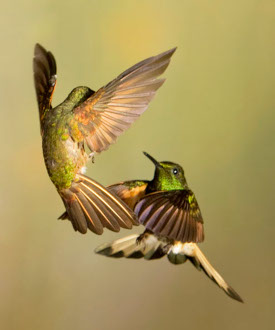
Two hummingbirds hover in the air. (Photo: © Tianne Strombeck)
BASCOMB: Yeah, a really kind of poignant part of your book is when when they get mites, and you have to treat them from mites. And one of them I believe you had to treat twice. And it sounds just so nerve racking.
MONTGOMERY: Oh, it was so awful. Oh my gosh, it was terrible. There's some hummingbird mites that are beak mites. And they they just, they're on your beak, you go to a flower, they transfer to the flower and everything is fine. But there's other mites that will suck your blood and make you itch and drive you insane. And they can kill them. And so we tried to get them off just by very gently trying to wipe them off with a q-tip. But there were too many. We took the little nest that they were in. And while we held the birds in our hands, we nuked the nest in the microwave, and dozens and dozens and dozens of horrible mites fell out. And we realized, oh my gosh, this infestation is really serious. We're going to have to treat them with insecticide. And as you know, you know, all insecticides can be lethal. And you've got to use just the right amount. And you also have to dip the birds in water, which they hated. And they peeped terribly after we applied the insecticide. They just sat there listlessly trying to recover from this and we could have killed them. It was horrible. We did not know, for many, many minutes if they were going to survive this. And it was during that time while we were waiting to see if they would recover from this treatment, that we finally decided to go against one of the things a lot of rehabilitators say they'll never do. And that is to name their charges. But we decided during that interval, that we loved them so much. They were individuals to us. And we named them we didn't want to just call them the big one and the little one. And that's when we named them Maya and Zuni. And they both survived.
BASCOMB: And what are the origins of those names?
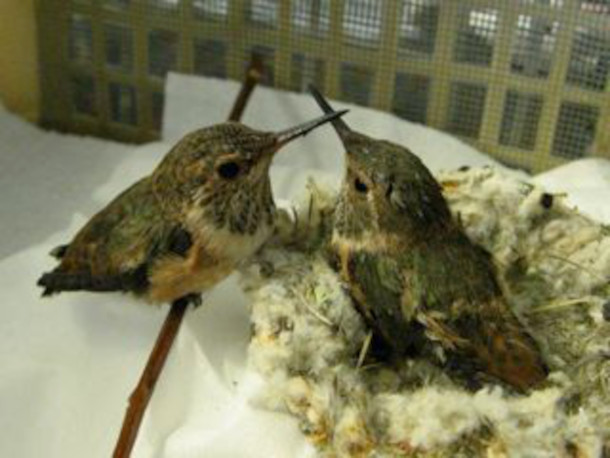
Maya and Zuni. (Photo: Courtesy of Sy Montgomery)
MONTGOMERY: Well, we actually had a lot of contenders. At first, I wanted to call the older one Aztec, because the Aztecs really admired hummingbirds, and they adorn statues of Montezuma with their feathers. But the Aztecs were too violent for Brenda. So she said something else. So what we decided on was for the larger bird, Maya, because the Mayans believed that hummingbirds were made from scraps left over when God created the other birds. Isn't that lovely? And those brilliant colors were a parting gift from the sun god. So Zuni, we named because like the Hopi and the Pima people, the Zuni believed that hummingbirds bring rain and we desperately needed rain. We needed a miracle.
BASCOMB: Yeah, you talk in your book that there's a lot of ancient cultures and traditions that have this association with hummingbirds and you're just talking about how tiny and how fragile and how very delicate they are, which of course they are. But they also have this association in other cultures of being this fierce warrior. Can you talk a bit about that?
MONTGOMERY: Yeah, they really are fierce. And if you have a hummingbird feeder, you've seen a hummingbird chase every other hummingbird away from the feeder that they insist is theirs. And people who've studied what hummingbirds do with their time have found that an individual hummingbird spends far more time chasing everyone else away from his feeder, even though there's plenty for everyone, far more time doing that than actually sipping or licking up the nectar themselves. So they do fight furiously and sometimes they'll just fall to the ground locked in combat. But the story that I love about the hummingbirds is one that the Spanish made up pretty much to explain how they could remain so gloriously beauty beautiful and pristine and, and how they could glitter so brightly. And these Spanish explorers called them resurrection birds for that reason. They said that to stay so pristine, surely they must die every night and be remade anew every morning.
BASCOMB: Wow, that's a beautiful sentiment. And at the same time that Aztecs, their god of war was actually a hummingbird.
MONTGOMERY: Yes. And I know it sounds like jeez, you know? That's kind of like the New Zealand Air Force has a flightless bird on its planes but, but really for ferocity, for tenacity, for strength, for maneuverability, agility, you can't do better than a hummingbird.
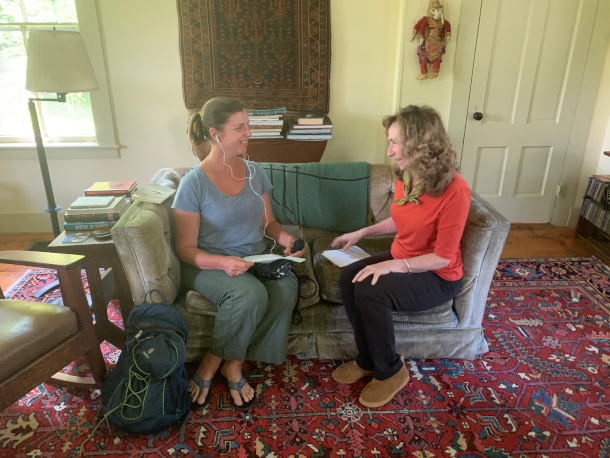
Bobby Bascomb (left) meets with Sy Montgomery (right). (Photo: Jay Feinstein)
BASCOMB: Yeah, it's amazing. I was looking at some pictures as I was getting ready for this interview. And if you look at a real close up of the beak of some species of hummingbird, it looks for all the world like a sword. Like a serrated sword. You know, if that was at any scale, it would be a really dangerous weapon, you can easily see why they're so fierce.
MONTGOMERY: Yeah, they totally will spear each other too. They want to.
BASCOMB: Do you have any favorite memories of your time with Zuni? And Maya? Perhaps that's an unfair question. But is there one that you really come back to and think of, you know, a poignant moment for you?
MONTGOMERY: Oh, there's so many, but one in particular that stands out, Maya was let go first, because typically, they are laid couple of days, the eggs are laid a couple of days apart, and you always have one bigger and one smaller hummingbird. So when we let Maya go, oh, it was so scary. We expected to see Maya again and waited, and waited and did not see him. Well, of course, he needed to feed. And every time he tried to come near a feeder, all these other adult hummingbirds chased him away. But what did he do? He came and got us. He came and got us. And we could actually go out and hold a feeder in our hands, that the other hummingbirds were afraid to approach. And he would feed directly from our hands.
BASCOMB: Wow, what a special memory to be able to hand feed a hummingbird.
MONTGOMERY: Yeah.
BASCOMB: So what should a listener do if say they find a, you know, abandoned hummingbird nest with a few orphans in it?
MONTGOMERY: Yeah, the first thing to do is to make sure that they're really abandoned. And wildcare is quite adamant about this, you need to watch for at least 30 minutes and not take your eyes off that nest to make sure that the nest really has been abandoned by the mother because the mother makes between 10 and 110 trips every day to get enough bugs and nectar to feed her babies. And she comes back and is gone in an instant. So make sure that you don't take your eyes off that nest. A lot of people are bringing in nests that aren't abandoned. And it's very hard to raise these, these little babies. But if you do find that the hummingbird nest has been abandoned, look up in your state wildlife rehabilitators and look to see who does birds and call the closest one. And as soon as you possibly can get the bird over there. If you find the nest in the evening and the place is closed, just make sure that it's not like on the ground so a cat is going to get it. You might want to try to take it inside and keep it warm, but do not try to feed or give any water to them. People feed these things the weirdest stuff, people who are trying to help and you think, you know, thank you for caring but particularly if it's an orphaned baby hummingbird, they need very particular precisely calculated food. So bring it to a rehabber and they will be delighted to take over.
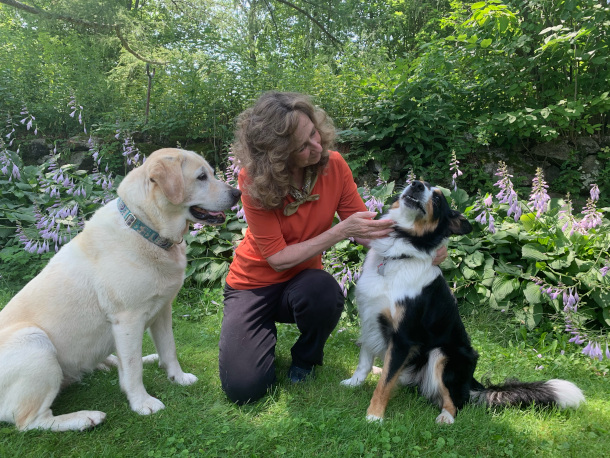
Sy Montgomery with her dog Thurber (right), as well as a friend’s dog (left). (Photo: Jay Feinstein)
BASCOMB: Leave it to the experts.
MONTGOMERY: Right.
BASCOMB: How did it feel for you when you finally released them? I mean, this is a labor of love, but it had to be kind of draining at the same time. You know, every 20 minutes. You got to feed these guys and also the exhilaration of seeing them finally, healthy enough to leave you.
MONTGOMERY: Yeah, It's bittersweet, you know. It's a hard world out there. You see all these bully hummingbirds, you know, that are chasing your baby away. But of course, you know, they're just doing what they have to do to survive themselves. But you've put so much love and care and time into these tiny little fragile lives, and you let them go. And within days, they're flying to Mexico. And your heart just goes with them.
BASCOMB: Beautiful. What do you hope that readers get out of your book?
MONTGOMERY: I hope that they see that miracles happen all the time, and that we can take a hand in them. And that even in small ways, we can heal the problems that are besetting our Earth. The hummingbirds to me, are a great symbol of hope. Because after all, you know, it's their fragility and their vulnerability that gives them their strength. And right now, so many of us are feeling vulnerable and fragile, and we don't know what's ahead. But if you look at a hummingbird, and what it's able to accomplish, the superlatives that it can achieve. Well, we should be able to help heal this earth we messed up to begin with.
BASCOMB: Sy Montgomery is the writer of The Hummingbirds' Gift: Wonder, Beauty, and Renewal on Wings. Sy, thank you so much for taking this time with me today.
Oh, thank you so much for coming. It was my pleasure.
CURWOOD: Living on Earth’s Bobby Bascomb, speaking with Sy Montgomery, author of The Hummingbird’s Gift: Wonder, Beauty, and Renewal on Wings.
Links
Living on Earth wants to hear from you!
Living on Earth
62 Calef Highway, Suite 212
Lee, NH 03861
Telephone: 617-287-4121
E-mail: comments@loe.org
Newsletter [Click here]
Donate to Living on Earth!
Living on Earth is an independent media program and relies entirely on contributions from listeners and institutions supporting public service. Please donate now to preserve an independent environmental voice.
NewsletterLiving on Earth offers a weekly delivery of the show's rundown to your mailbox. Sign up for our newsletter today!
 Sailors For The Sea: Be the change you want to sea.
Sailors For The Sea: Be the change you want to sea.
 The Grantham Foundation for the Protection of the Environment: Committed to protecting and improving the health of the global environment.
The Grantham Foundation for the Protection of the Environment: Committed to protecting and improving the health of the global environment.
 Contribute to Living on Earth and receive, as our gift to you, an archival print of one of Mark Seth Lender's extraordinary wildlife photographs. Follow the link to see Mark's current collection of photographs.
Contribute to Living on Earth and receive, as our gift to you, an archival print of one of Mark Seth Lender's extraordinary wildlife photographs. Follow the link to see Mark's current collection of photographs.
 Buy a signed copy of Mark Seth Lender's book Smeagull the Seagull & support Living on Earth
Buy a signed copy of Mark Seth Lender's book Smeagull the Seagull & support Living on Earth

